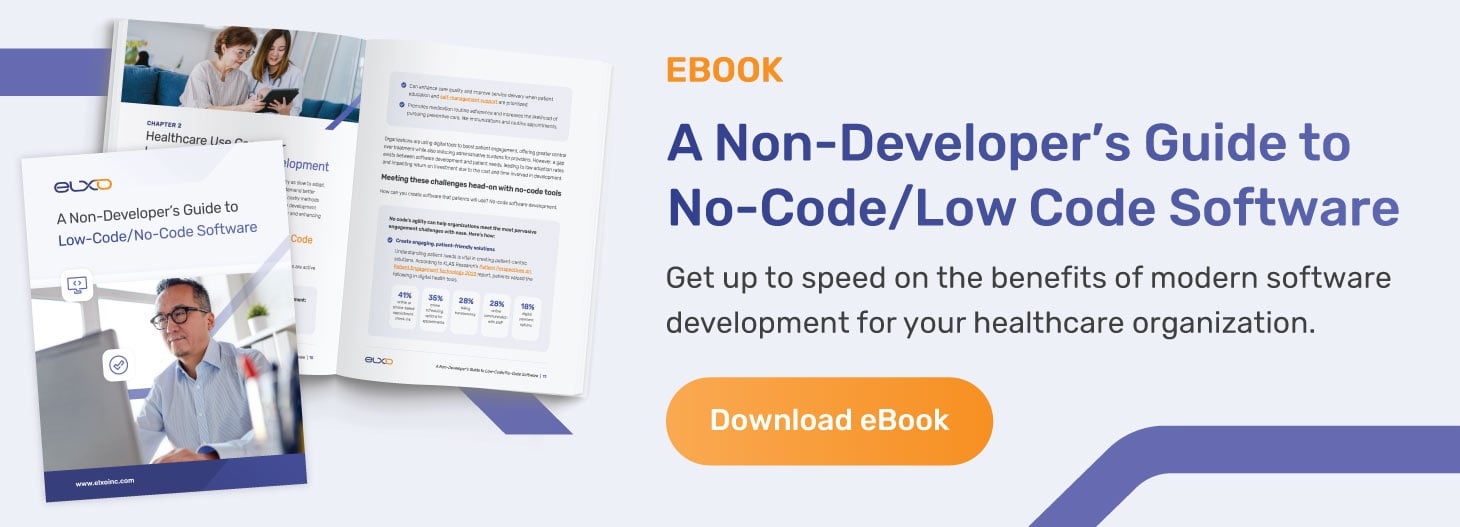In healthcare, technology solutions are often centered on the patient — as they should be — but the clinical team experience needs consideration, too. Digital tools shouldn’t add to operational burden; instead, they should streamline the work of healthcare staff. The improvements they bring can drive better care delivery and outcomes.
As Harvard Business Review notes, there are two things providers need to do to help patients get the right care at the right time: evaluate patients’ needs accurately and manage hospital resources effectively. Software can play a vital role in optimizing the quality and efficiency of clinical operations, but the traditional medical software development process can be costly, cumbersome, and complex.
No-code/low-code software development takes a more modern and accessible approach to building the digital tools both patients and providers need. Here’s how this method can enhance operations as well as clinical decision support at scale:
It provides a faster path to workflow automation.
Automating healthcare workflows can reduce the burden of arduous administrative tasks on providers and staff, increase efficiency, and enable better experiences for patients and caregivers. But the tricky part is designing and implementing workflows that are effective.
The entire organization needs to be aligned in achieving automation goals, which means gathering input from all teams and building a process that works for everyone. In practice, this often requires frequent workflow tweaks – but building a system that can handle them is expensive.
No-code/low-code tools offer a more cost-effective and faster path to automation because they’re designed to be flexible and easy to use. Non-tech-savvy users can give their input at the design stage, and preferred features can be dragged and dropped into the workflow. Workflows can be stood up quickly, and as users provide feedback, processes can be easily updated.
As a result, the organization is able to enjoy an optimized, automated workflow sooner rather than later, which enables staff to spend more time in direct patient care instead of grappling with fragmented processes.
It cultivates better patient management and care coordination.
No-code/low-code solutions have many features that can also help streamline patient management through automation. For example, they can easily integrate with electronic health records and pull information into the workflow where needed. This can help providers keep patient files up to date and double-check relevant information, such as the medication a patient is taking or the treatment plan they’re following.
When staff have access to up-to-date patient data, including medical history, medical device data, prior patient encounters, and more, they can make more informed decisions and provide more effective care. Such tools can also enhance information sharing with other departments or facilities, improving care coordination across the health system.
No-code/low-code automation replaces the manual process of uploading, updating, reviewing, and sharing data, making it easier to track patients throughout their care journey. By automating these tasks, clinical teams can be more confident that they’re on the same page, and providers can spend less time tracking down patient data while balancing busy workloads.
It elevates clinical decision support.
According to a study in NPJ Digital Medicine, clinical decision support systems have been shown to assist healthcare providers in a variety of decisions, including those related to diagnoses, patient-facing support, administrative functions, clinical management, and more. These systems can actively support the delivery of quality care; however, common pitfalls can hamper their success.
The good news is these pitfalls are avoidable, and no-code/low-code platforms can help navigate around them. For example, quality of data is critical to operational effectiveness, but poorly designed systems make it difficult to standardize data collection. With a no-code/low-code approach, you can centralize your organization’s clinical data repository. This makes it easier for providers to update information on diagnoses and treatment plans and keep rules and protocols current.
The flexibility of no-code/low-code software can also simplify integration and ongoing maintenance — two other major pitfalls for clinical support systems, which often struggle with interoperability and connectivity between systems.
It enables more agile and flexible program scaling.
Healthcare programs and workflows need to be designed with scaling in mind. For example, what happens if there’s a sudden influx of patients to your facility due to an infectious virus? What if a merger or acquisition is completed, and patients and doctors need to be shuffled around? What if inclement weather shuts down a facility, leaving others to handle the burden temporarily?
Regardless of the scenario, healthcare organizations need to be prepared for the changing tides. No-code/low-code medical software development is designed to rapidly evolve and scale on all fronts. New features can be rolled out when ready, old features can be removed when obsolete, and workflows can be reworked with a few clicks.
This agile approach to development enables healthcare organizations to deploy solutions quickly and adjust on the fly. It also leaves space for experimentation (think: incorporating AI elements) and refinement (think: building out effective low-code features). These solutions can flex as programs undergo changes, whether they’re bringing on more users, downsizing, or optimizing to the perfect fit.
Examples of no-code/low-code automation
Here are some real-world examples of how no code/low code can best be used:
- A leading medical and health insurance group in the U.S. was grappling with an overly complex referral-to-surgery workflow. Providers were facing a disproportionate number of process complications, and the burden was especially heavy on nurses, who had to manually process about 150 referrals per month.
Elxo developed a bespoke solution featuring low-code automation to streamline that workflow for more than 1,500 patients and 30 staff members. One feature included a quick view of where patients were in the workflow, enabling staff to divert resources as needed to move patients along quicker.
This automated process delivered a faster referral-to-surgery workflow, and with low-code enablement, there’s room to build on the solution, scale it, and make adjustments. - To enhance clinical decision-making, a no-code solution can be leveraged to create data visualizations and dashboards. Typically, data analytics tools built from scratch require extensive integration work to centralize data sources and feed the right type of data into the right applications.
The purposefully flexible architecture of no-code medical software development is designed to simplify integrations, no matter how complex. This makes it easy to connect various data sources, generate visualizations or reports, and share insights across the organization.
An agile implementation of no-code analytics can empower clinical team members in making more informed decisions, whether those decisions are focused on resource provisioning, operational efficiency, or patient outcomes.
The best approach to software development is partnering with a vendor that offers robust services and listens to your needs. This will help ensure your most complex process and workflow problems are solved.
No-code/low-code automation, and even fully custom medical software development, can help healthcare organizations do what they’ve been trying to do for decades: build a solution that balances both the patient and the provider experience. This approach is also key to developing the tools required to keep pace with today’s modern healthcare landscape — without breaking the budget.
Looking for a way to free up your patient care team and boost clinical operations? Get started with Elxo.






